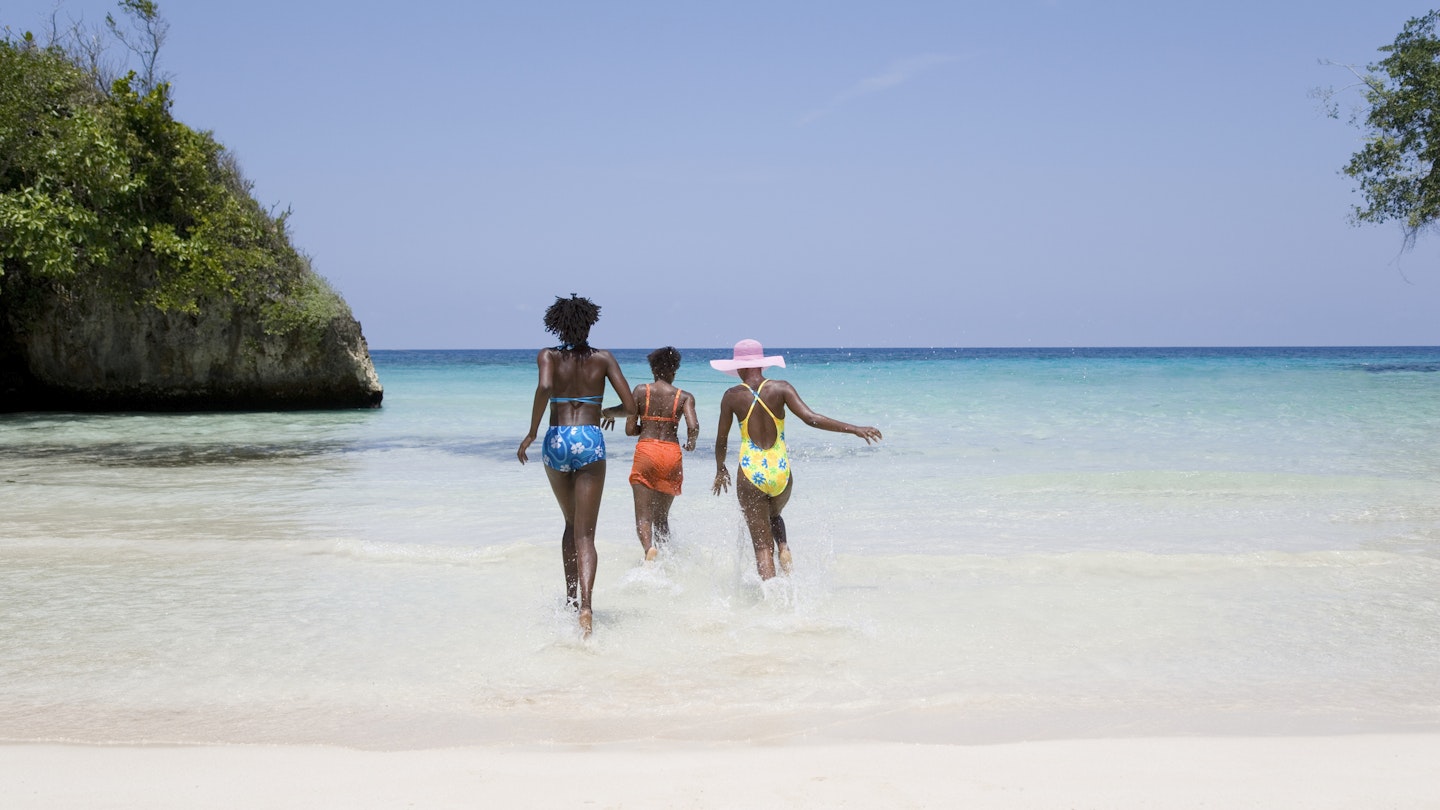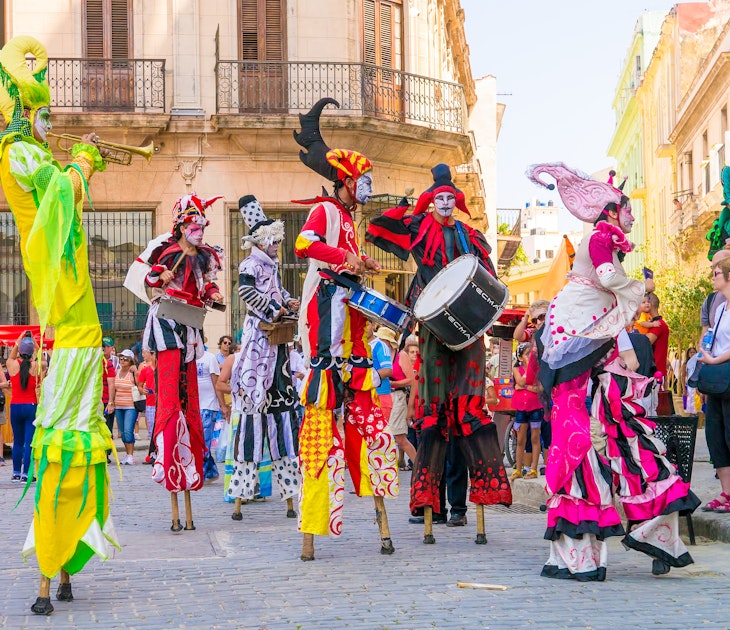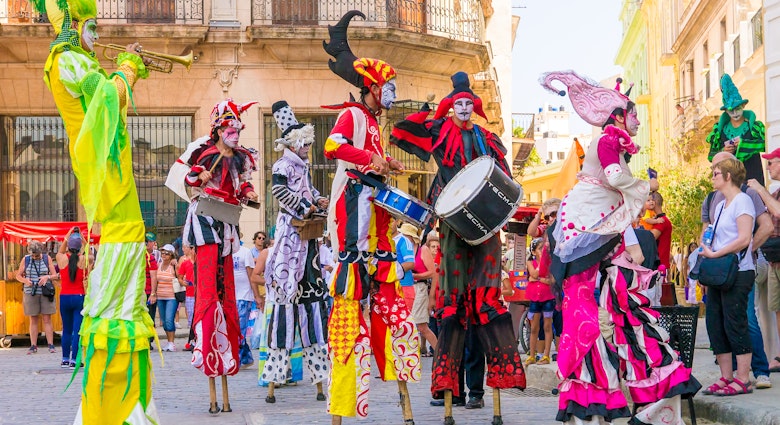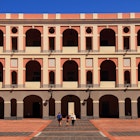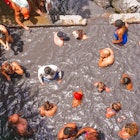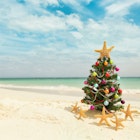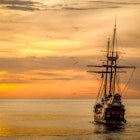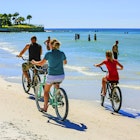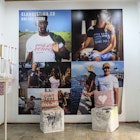Set between the beauty of the Caribbean Sea and the craggy ridges of the Blue Mountain range, Jamaica’s attractions range from hidden waterfalls and white-sand beaches to historical architecture, great food and unique ecosystems.
But the island's allure extends well beyond nature – when it comes to music, sports and culture, few places can rival Jamaica. These are the top experiences you can't miss and that will keep you coming back for more.
1. Splash about at Reach Falls
On Jamaica’s remote east coast, Reach Falls are arguably the most spectacular on the island and receive a fraction of the visitors who flock to the more accessible Dunn’s River Falls.
Local guides will help you as you walk up the river, keeping your belongings safe and dry while pointing out the best places to snap photos as you splash in jade-colored pools shaded by jungle vegetation, climb up limestone crags and get pummeled by jets of water in the “washing machine." The more adventurous have the option of climbing up to Mandingo Cave.
2. Vibe with locals at Winnifred Beach
East of Port Antonio on Jamaica’s north coast, a steep road leads down to the public beach, which is, as yet, mercifully undeveloped and one of the island's best beaches.
Winnifred Beach is a beautiful stretch of white sand popular with Jamaicans, particularly on the weekend when the bass booms from competing sound systems. Food and drink stands supply nourishment in the form of curry goat, brown stew fish and jerk chicken.
Planning tip: The beach is maintained by the local community, so bring some cash and make a donation if you can.

3. Hit the dance floor in Kingston
As befitting any capital worth its salt, Kingston never sleeps and its nightlife is second to none. You can try out the latest moves on the dance floor alongside the locals dressed in their best jeans and “batty riders” (short shorts) at uptown nightclubs such as Taboo, Fiction and Kingston Dub Club.
Planning tip: Look out for posters advertising all-night reggae music fests, taking place near Half Way Tree featuring a dozen or so big-name performers who sometimes hang out with the audience after their set.
4. Fill your belly with jerk pork
One of Jamaica’s most iconic dishes, jerk pork, is cooked in oil drum grills by street vendors in Kingston and elsewhere, smoked in roadside cookshops and even served at high-end restaurants.
Jerk pork harkens back to the traditional Maroon way of preserving the meat: it’s marinated with Scotch bonnet chilies, allspice, garlic, thyme and spring onion and smoked slowly over pimento (allspice) wood fire for that unique taste.
It’s quite dry and smoky, with a spice and sweetness to it. The slabs of dark meat are precision-chopped by the cook and typically served with homemade hot sauce drizzled on top.
Planning tip: Every Jamaican has their own opinion regarding the best recipe and the best place to sample it. Our tip is to head for the roadside grills in Boston Cay on the east coast, where you can try some of the most authentic jerk pork on the island.
5. Attend a reggae festival
Reggae Sumfest – a week-long music festival – is Jamaica’s music event of the year, and it typically features some of the biggest names in reggae and dancehall. A beach party on Walter Fletcher Beach in Montego Bay kicks off the festival with days of nonstop revelry at the Catherine Hall Entertainment Centre.
Imagine rocking out with musicians like Beenie Man, Damian “Jr Gong” Marley, The Mighty Diamonds, Capleton and Alicia Keys at night, then catching a nap on the sand at sunrise.
If you’re looking for pure, old-school roots reggae by the likes of Burning Spear and The Maytals, then don’t miss the two-day Rebel Salute Festival in mid-January near St Ann’s Bay at Plantation Cove.
Much of the action takes place at night, with the whole atmosphere wreathed in the fragrant smoke of “di herb.”
6. Enjoy mellow vibes at Treasure Beach
The antithesis to the brash beach resorts of Montego Bay, Negril and Ocho Rios, Treasure Beach on Jamaica’s south coast is a timeless, off-beat village spread out across four coves – Billy’s Bay, Frenchman’s Bay, Calabash Bay and Great Bay – and home to a community of fishers, artists and other bohemians.
A mellow vibe prevails; there are no hustlers here, and largely deserted beaches greet you. Locally owned guesthouses are the norm.
For activities, you'll be spoiled for choice. Take a boat ride out to sea to the Pelican Bar, a drinking establishment housed in a thatched hut on a sandbar 1km (0.62 miles) from shore. Dine on I-tal food (natural foods) at Rasta-owned cookshops. Go to nearby Alligator Pond for some of Jamaica’s best seafood.
Take a walking tour with local historian Lilieth Lynch or partake in the biannual Calabash Festival, celebrating some of the brightest literary talents in Jamaica and beyond.
7. Tour the Bob Marley Museum
For Marley aficionados, no trip to Jamaica is complete without paying homage to Bob at his former home on Hope Rd in Uptown Kingston. The spacious, creaky wooden house is kept largely as it was when Marley lived there from 1975 until he died in 1981.
You can see the gold and platinum records lining the walls, clippings from his last tour, his rather austere bedroom and favorite stage shirt, and the bullet holes in the back wall from an assassination attempt in 1976.
Don’t miss the former recording studio turned into an exhibition hall, where a short video is played at the end of the visit.
Planning tip: Fair warning, this is a really popular tourist spot – expect crowds and inflated tourist prices.
8. Climb Dunn’s River Falls
A nearly 3km (1.8-mile) taxi ride west of Ocho Rios takes you to one of Jamaica’s most famous attractions. Popular with Jamaicans, cruise ship crowds and everyone in between, Dunn’s River Falls (originally called Xayamaca – land of rivers and springs – by the Arawak) is a truly stunning sight.
Start at the bottom of the falls, flanked by the jungle on both sides, and work your way up numerous tiers of limestone, splashing in clear blue pools and clambering up slippery, rocky outcrops amidst pounding spray. The currents are quite strong in places, so it’s best to go with friends.
Planning tip: Day-trippers clog the trails when a cruise ship is in town, so try to avoid visiting on those days if you can.

9. Raft the Martha Brae and Rio Grande
Floating downriver at a sedate pace on rafts made of bamboo was made popular by actor Errol Flynn in the 1950s and is still one of the most popular experiences on Jamaica’s north coast – both on the Rio Grande and the Martha Brae.
The rafts accommodate two passengers and a “captain” who propels the raft through green tunnels of verdant vegetation using a long pole. Along the way, you can stop at popular swimming spots or slip off the raft to float alongside it.
Planning tip: The water is refreshingly cold, and the experience can be romantic or boisterous, depending on how crowded the river is at the time.
10. Celebrate the Accompong Maroon Festival
Witness a unique slice of Jamaican history by celebrating the unofficial Maroon New Year in Accompong. This village on the edge of the Cockpits – Jamaica’s no-man’s-land of sinkholes, limestone cliffs and impenetrable jungle – is populated by the proud descendants of runaway enslaved people who successfully waged a guerrilla war against the British.
January 6 marks the signing of the 1739 Peace Treaty, in which the British committed to leaving the Maroons alone.
The day is celebrated with a procession up the main street, chanting in Coromantee (a West African language), the beating of traditional goombeh drums and the blowing of abeng cow horns (like those once blown by runaway enslaved people as a call to arms).
Following the procession come the 21st-century festivities – sound systems blast out dancehall music till dawn, and young people show off their best moves as the fragrant smoke from the jerk chicken and pork stalls entices hungry revelers.
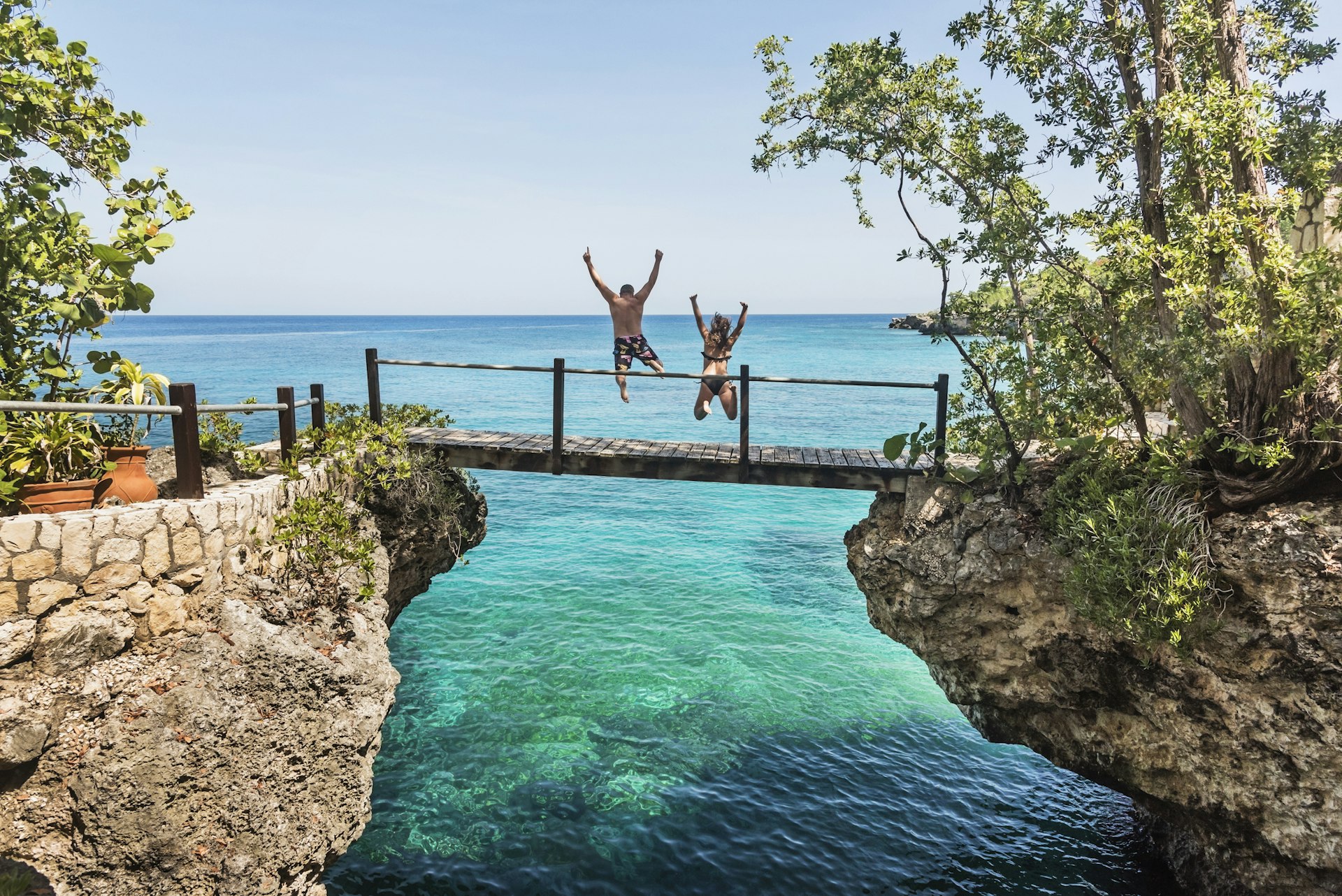
11. Marvel at the beauty of Negril
Love it or hate it, the west coast beach town of Negril is hard to ignore. It’s by no means the fishing village it was in the 1970s, yet it still retains pockets of serenity in its southern half – West End – where boutique hotels sit atop precipitous limestone cliffs that plunge into the sea and local-run guesthouses nestle in the jungle.
The northern half of Negril – full of beach resorts and restaurants – is spread out along the misnamed, white-sand Seven Mile Beach (just over four miles long) and home to beach parties several nights a week.
Despite the commotion, there’s no denying the beauty of the setting. And whether you’re looking to jump off cliffs at Rick’s Cafe in the West End, try a plethora of water sports or watch the sunset while digging your toes in the sand at a beachside cookshop, Negril rarely disappoints.
12. Admire the art at the National Gallery of Jamaica
This superb art gallery in Downtown Kingston is the definitive, unmissable collection of Jamaican art through the ages.
Works run the gamut from centuries-old stone carvings by the Taino people – Jamaica’s earliest inhabitants – to bucolic Caribbean landscapes by 18th-century British artists and the abstract and surrealist art movements of the 20th century. Don’t miss the temporary exhibitions showcasing the best of contemporary Jamaican art.

13. Climb Blue Mountain Peak
A rite of passage for outdoorsy Kingstonians and a must for any hiker is the ascent of Blue Mountain Peak (2,256m/7,401ft), Jamaica’s highest mountain. First, you'll overnight at Whitfield Hall, a hamlet in the foothills of the Blue Mountain range, where you're fed a home-cooked dinner of curry goat, oxtail and beans.
That night, attempt to grab a few hours of sleep before being woken up by the hiking guide at around 2am to reach the peak in time for sunrise.
As you climb higher, jungle vegetation gives way to pine trees, “old man’s beard” lichen, ferns and evergreens, and you’ll see sparks flying all around you – fireflies, locally known as “kittyboo” or “peenie-wallies.”
The ascent takes around four hours. There’s something otherworldly about watching the sun rise above the mist-shrouded Blue Mountains. Returning to Whitfield Hall means you’ve earned the breakfast of champions: Jamaican staples such as ackee, saltfish or mackerel rundown accompanied by Blue Mountain coffee (of course). The range is part of a national park, just one of Jamaica's wonderful green spaces.
Planning tip: If you're lucky enough to be at the peak on a particularly clear day, you can see the faint outline of Cuba in the distance.
14. Get a history lesson at Port Royal
The buccaneer capital of the Caribbean was the “wickedest city on earth” for much of the 17th century with brothels, free-flowing rum and frequent pirate raids on merchant ships and Spanish territories until the great earthquake of 1692 wrecked the place.
Today, it’s a small village with a tremendous history, easily reachable from Kingston by bus and one of the best places to put on your Jamaican itinerary. You can tour historic buildings like Fort Charles, the Old Naval Hospital and the Old Gaol or hire a local fisher to give you a boat ride to the nearby bucolic white-sand sliver of Lime Cay.
Planning tip: Here on a Sunday? Have lunch at Gloria’s, a seafood establishment much loved by Kingstonians.
15. Spot a croc on the Black River Great Morass
Small boats departing from the former 19th-century port of Black River on the south coast take you deep into the salt marsh and mangrove maze of the Great Morass, home to several hundred American crocodiles.
This unique ecosystem is also home to over 100 bird species, from herons to whistling ducks. Tours depart from the bridge and last an hour or longer, with the boat guides pointing out the best swimming holes where you can splash without being troubled by crocs. You might even see locals tending to their bamboo crayfish traps the way they’ve done for centuries.
16. Sample rum at the Hampden Great House Estate
The sweet smell of molasses greets you as you set foot on the palm-fringed, landscaped grounds of the centuries-old Hampden Great House Estate, complete with wandering peacocks.
Reachable via back roads from Falmouth toward the village of Wakefield, the estate introduces visitors to the world of rum distillation. Guides take you inside the rum factory and fermentation house and explain the distillation process. Tours include Jamaican standards for lunch and rum tastings.
17. Explore the history of Falmouth
It’s hard to believe that between 1769 and the 1840s, this north-coast town was Jamaica’s busiest port. The Tropical-Georgian architecture lining the grid of quiet streets was paid for with wealth amassed from the labor of enslaved people through the sugar plantation.
A rather soporific town today, somewhat marred by the massive, brash cruise ship pier, Falmouth nevertheless is an essential destination for visitors with an interest in history and architecture.
Take a walking tour of the town and learn about various historic landmarks, such as the church where the abolitionist William Knibb used to preach or the wharf where enslaved Africans were brought to the Americas.
There's also an early-19th-century British fort and a Jewish cemetery, where some of Jamaica’s earliest Jewish inhabitants are buried.
18. Cool off at Mayfield Falls
Popular with locals as well as visitors and tricky to reach (via a potholed minor road either from Savannah-la-Mar or Lucea Harbour), Mayfield Falls is a wonderful water playground.
Thickets of bamboo frame the cool, clear river, and as your guide leads you upstream, you plunge from outcrops into natural pools, traverse an underwater tunnel (if you’re feeling brave), and splash around in the foam churned up by a natural “jacuzzi.”
